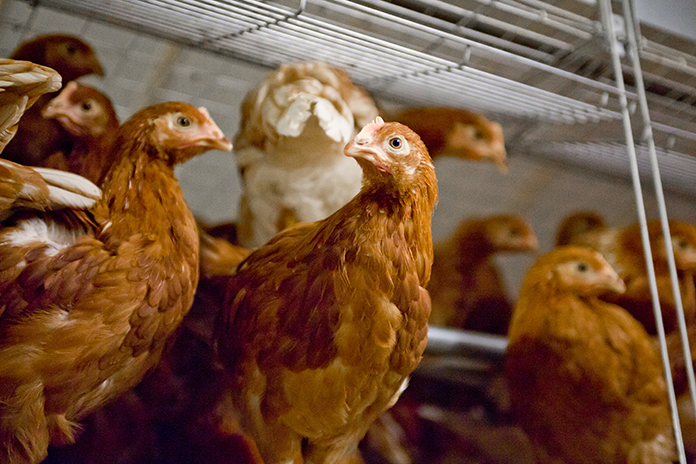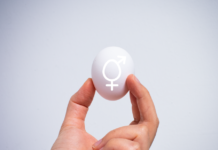
Induced molting is a process conducted by many commercial egg producers to extend the productive life of the laying hen. The main objective of a good molting program is to cause hens to totally cease egg production and enter a non-reproductive state. In the past 10-15 years, research on molting commercial layers has examined non-feed-withdrawal methods that do not negatively effects the welfare of the hen.
Non- feed-withdrawal methods have included the feeding of a combination of wheat middlings and corn, different ratios of alfalfa or layer diet, high cottonseed meal, high levels of zinc, combinations of corn and soybean hulls, varying levels of distillers dried grains with. In general, an acceptable molt diet which is often used in the industry is a diet containing low levels of protein and energy.
Research using different nutritional ingredients
Alternative molting programs employed using a non-feed withdrawal molting program examined the effects of feeding high corn, wheat middlings, corn gluten feed, dried distillers grains with solubles (DDGS), and combinations of wheat middlings and corn. These studies revealed that a combination of corn and wheat middlings seemed to work well. The Author also conducted studies using DDGS in two experiments where hens were fed molt diets containing 47% corn:47% soybean hulls, 94% corn, and 94%.
In that study, the corn:soybean hulls diet was fed ad libitum, while the corn and DDGS diets were limited. The reason for this was because the energy level of those diets were about twice that of the corn:soybean hulls diet. This work demonstrated that limit feeding the corn and DDGS diets yielded long-term post molt performance compared to that observed by limit feeding a corn:soybean hulls diet. In a follow-up study, the Author fed varying levels of corn, wheat middlings, and DDGS diets and compared that to a corn:soybean hulls diet.
More recently, Bland et al., (2014) evaluated the feeding of Hy-Line W-36 hens with 3 sources of DDGS alone or in combination with corn, soybean hulls, and DDGS. These diets were compared to the positive control of 47% corn and 47% soybean hulls. Overall, the results of this study showed the molt and post molt performance responses varied among DDGS sources, however, none of the DDGS diets yielded reduction in BW or egg production that was similar to the 47% corn:47% soybean hulls diet. Thus, molting research has show that a corn:soybean hulls diet that contain about the same amount of each ingredient seems to work well for molting Hy-Line W-36 hens.
Gongruttananun et al., (2013) studied the short term effects of using cassava meal, broken rice, or corn on ovarian regression, bone integrity, and post molt egg production in 95-wk old laying hens. In an interesting study by Dickey et al., (2012), Hy-Line W-36 hens were fed a calcium premolt treatment and low-energy diets vs. a traditional feed withdrawal (FW) treatment during and after a molt. In this study, 2 calcium premolt treatments (fine and course) and 3 molt diets (FW, soybean hulls, and wheat middlings) were tested.
The results of this study showed that the fine-Ca premolt treatment was more effective than the course-Ca treatment at decreasing egg production during the molt period, and increasing it during the post molt period. The soybean hulls diet resulted in lower production and ovary and oviduct weights during the molt than the wheat middlings molt diet.
Since the early 2000’s, Dr. Ken Anderson, NC State University, has utilized a low protein and low energy molting program in the yearly North Carolina Layer Performance and Management tests. This program has involved monitoring post molt performance of 6 – 10 white and brown strain layers. At Day -7, sample body weights of the birds are taken and the target body weight is determined. On Day 0, birds would be fed a “non-anorexic” molt diet and the photoperiod would be reduced to 9 hours. On Day 7 and 9, body weights would be taken of the same birds as measured on Day -7. The calculated target body weight loss should be no more than 20%. Then, on Day +28, body weights would be taken again and the birds would be fed a regular layer diet and light stimulated. The non-anorexic molt diet used is mainly a combination of corn, soybean hulls, and some wheat middlings.
It has an analyzed protein and energy content of 9.9% and 1650 kcal/kg of ME. This diet has been used because it is balanced for the appropriate levels of vitamins and minerals required for body maintenance and it is used to maintain a healthy anovulatory state. Anderson and Havenstein (2007) reported in a North Carolina Random Sample test that acceptable post molt performance occurred for both white and brown egg strains when using the non-anorexic program, vs. the original conventional (feed withdrawal) method.
Molting hens following confirmation of an HPAI outbreak
As everyone knows, last year was a challenging one in regards to bird losses in the commercial egg and turkey industries due to the HPAI outbreaks in USA. One of the possible effects of this problem might have been the disruption of pullets being able to be moved into layer facilities in a timely manner. To address this issue, Karcher et al., (2015), provided some suggestions as to what could be done to delay the onset of lay of a pullet flock that was scheduled to be moved to the layer facilities.
In this article, an alternative strategy was suggested to accomplish the delay in the onset of production. It was suggested that producers should step-down the lighting program to 6 to 8 hours of light. The diet should be modified to increase the fiber content and reduce the protein level which would decrease feed consumption. In addition, pullet body weight should be closely monitored. Another strategy was also mentioned.
Early work done by Strong (1992) showed that a 5-day fast done early in the production cycle (22 weeks of age) resulted in decreased body weights and reduced early egg size. This was followed up by Koelkebeck et al. (1993) which demonstrated that a 4- and 7-day feed withdrawal period did induce hens to stop egg production and induced them to molt. Using these two research studies as a guide, if producers wanted to delay the onset of egg production of a pullet flock then they should be fed a non-feed withdrawal molt diet and reducing the day length to 6 hours a day.
Molting programs used in the commercial egg industry
On January 1, 2006, the United Egg Producers (UEP) stipulated that an egg production company wanting to be a part of their Certified Egg Producer Program, had to utilize a non-feed withdrawal molt program. The molting program followed by many companies in the industry is one recommended by Hy-Line International for their W-36 strain of laying hen. This program focuses on making sure that the body weight reduction goal is to maintain the 18 week pullet body weight when the birds come into production. This is achieved by photoperiod reduction and the feeding of high fiber (low in energy) diets with fine-particle CaCO3 and no added sodium (Na).
In addition, the feed intake should be reduced to 12 to 14 lbs. per 100 birds per day for the first 17 days of the molt period, then, start feeding a limited amount of a layer diet at 18-19 days of the molt, and increase it to full feed on Day 21 of the molt period. The recommended protein and energy level of the molt diet is 8.50% protein and 2205-2800 kcal/kg of ME. If a producer follows this type of program, then the flock should increase egg production to around 50% about 6 weeks following the initiation of the molt process.
In discussions with several egg producers, the following procedures have been used:
- Photoperiod: reduce to 8 hours per day the week prior to starting the molt. Alternative: increase day length to 24 hours – 4 days prior to the start.
- Feed: continue to feed a layer diet with fine particle CaCO3 the week before
- Start: change feed to a low protein, low energy molt diet and limit-feed to 10-12 lbs./100 hens per day (run the feeder chain or auger less and shorter time). The molt diet would be fed for around 3 weeks or so, then the hens should be put back on a layer diet.
- Body weights: monitor body weights the week prior to starting and after the start. Take body weight down to an 18-19 week old pullet weight; but not less. This weight would be around 2.7 lb./bird not lower than that.
- So, the time period from 50% premolt egg production to 50% post molt egg production should be around 5-6 weeks (Fast Molt).
Research conducted on using different feed ingredients for a non-feed-withdrawal molting program have indicated that a combination of corn, soybean hulls, wheat middlings, and other low protein and energy ingredients are the ones most often used with success. For egg production companies that do use a non-feed-withdrawal method to molt their flocks, some combination of the above ingredients should work well. These companies have tweaked the mechanics of using this type of molting program. The specific ingredients that are used, depends on factors such as price of the ingredients and availability of them.
References are available on request

















